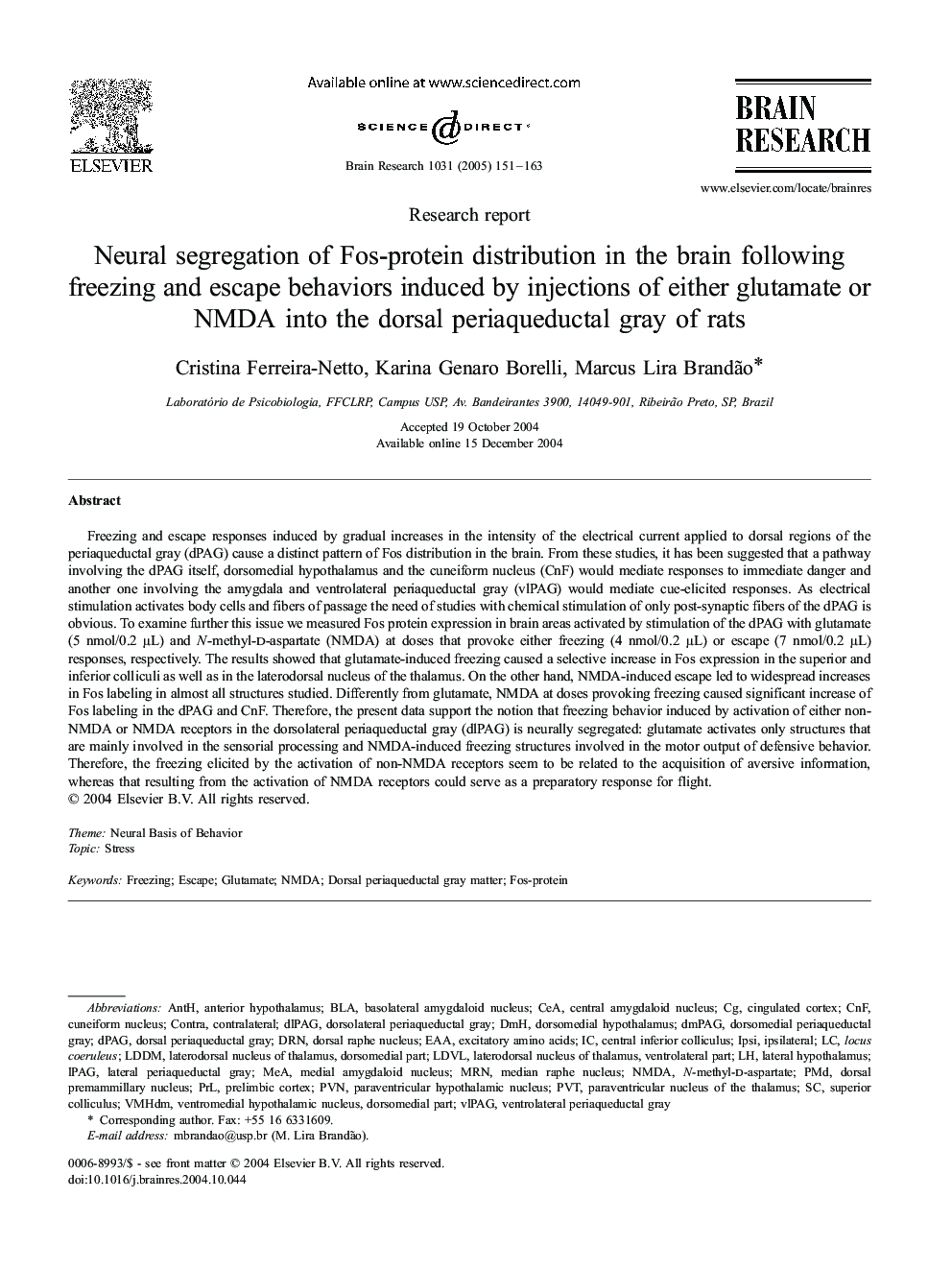| کد مقاله | کد نشریه | سال انتشار | مقاله انگلیسی | نسخه تمام متن |
|---|---|---|---|---|
| 9416846 | 1292986 | 2005 | 13 صفحه PDF | دانلود رایگان |
عنوان انگلیسی مقاله ISI
Neural segregation of Fos-protein distribution in the brain following freezing and escape behaviors induced by injections of either glutamate or NMDA into the dorsal periaqueductal gray of rats
دانلود مقاله + سفارش ترجمه
دانلود مقاله ISI انگلیسی
رایگان برای ایرانیان
کلمات کلیدی
BLALDvlDMPAGdlPAGdPAGEAADMHDRNCNFCeA - CEAipsi - آنهاStress - استرس یا فشار روانیexcitatory amino acids - اسیدهای آمینه هیجان انگیزdorsomedial periaqueductal gray - خاکستری پرایاکتومیdorsolateral periaqueductal gray - خاکستری پرایاکتیوال دو طرفهdorsal periaqueductal gray - خاکستری پرایکتون پشتی پشتیipsilateral - دو طرفهAnth - دومcontra - علیهlocus coeruleus - لوکوس سیرولئوسNeural Basis of Behavior - مبانی عصبی رفتاریbasolateral amygdaloid nucleus - هسته آمیگدولئید basolateralcuneiform nucleus - هسته خمیدهdorsal raphe nucleus - هسته رافهcentral amygdaloid nucleus - هسته مرکزی amygdaloiddorsomedial hypothalamus - هیپوتالاموس dorsomedialanterior hypothalamus - هیپوتالاموس قدامیcontralateral - کنتراست
موضوعات مرتبط
علوم زیستی و بیوفناوری
علم عصب شناسی
علوم اعصاب (عمومی)
پیش نمایش صفحه اول مقاله

چکیده انگلیسی
Freezing and escape responses induced by gradual increases in the intensity of the electrical current applied to dorsal regions of the periaqueductal gray (dPAG) cause a distinct pattern of Fos distribution in the brain. From these studies, it has been suggested that a pathway involving the dPAG itself, dorsomedial hypothalamus and the cuneiform nucleus (CnF) would mediate responses to immediate danger and another one involving the amygdala and ventrolateral periaqueductal gray (vlPAG) would mediate cue-elicited responses. As electrical stimulation activates body cells and fibers of passage the need of studies with chemical stimulation of only post-synaptic fibers of the dPAG is obvious. To examine further this issue we measured Fos protein expression in brain areas activated by stimulation of the dPAG with glutamate (5 nmol/0.2 μL) and N-methyl-d-aspartate (NMDA) at doses that provoke either freezing (4 nmol/0.2 μL) or escape (7 nmol/0.2 μL) responses, respectively. The results showed that glutamate-induced freezing caused a selective increase in Fos expression in the superior and inferior colliculi as well as in the laterodorsal nucleus of the thalamus. On the other hand, NMDA-induced escape led to widespread increases in Fos labeling in almost all structures studied. Differently from glutamate, NMDA at doses provoking freezing caused significant increase of Fos labeling in the dPAG and CnF. Therefore, the present data support the notion that freezing behavior induced by activation of either non-NMDA or NMDA receptors in the dorsolateral periaqueductal gray (dlPAG) is neurally segregated: glutamate activates only structures that are mainly involved in the sensorial processing and NMDA-induced freezing structures involved in the motor output of defensive behavior. Therefore, the freezing elicited by the activation of non-NMDA receptors seem to be related to the acquisition of aversive information, whereas that resulting from the activation of NMDA receptors could serve as a preparatory response for flight.
ناشر
Database: Elsevier - ScienceDirect (ساینس دایرکت)
Journal: Brain Research - Volume 1031, Issue 2, 21 January 2005, Pages 151-163
Journal: Brain Research - Volume 1031, Issue 2, 21 January 2005, Pages 151-163
نویسندگان
Cristina Ferreira-Netto, Karina Genaro Borelli, Marcus Lira Brandão,